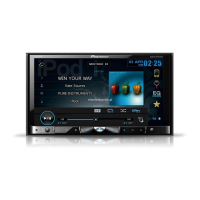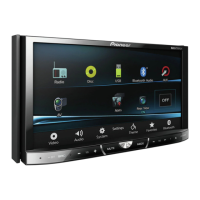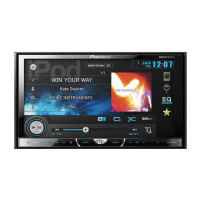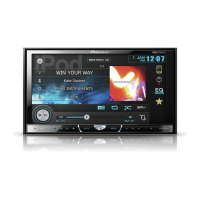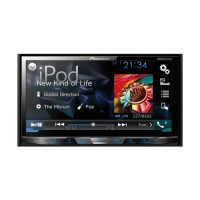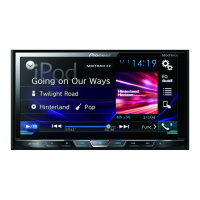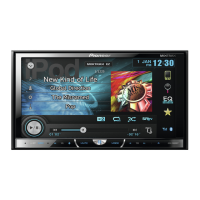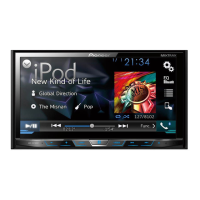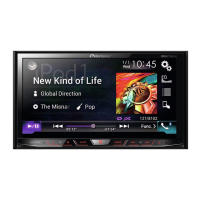How to fix no sound on Pioneer Car Receiver?
- RRichard CobbAug 18, 2025
If there is no sound or the volume level is low on your Pioneer Car Receiver, first adjust the volume level. If that doesn't work, check if the attenuator is on and turn it off.
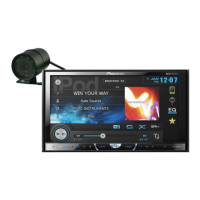
How to fix no sound on Pioneer Car Receiver?
If there is no sound or the volume level is low on your Pioneer Car Receiver, first adjust the volume level. If that doesn't work, check if the attenuator is on and turn it off.
What to do if my Pioneer AVH-X5500BHS Car Receiver power will not turn on?
If your Pioneer Car Receiver will not turn on, double-check that all leads and connectors are correctly connected.
What to do if my Pioneer Car Receiver says to check the speaker connection?
If your Pioneer Car Receiver displays a message to check the speaker connection, and the message persists after restarting the engine, seek assistance from your dealer or an authorized Pioneer Service Station.
Why is there no image displayed on my Pioneer AVH-X5500BHS Car Receiver?
If there is no image displayed on your Pioneer Car Receiver, it could be due to a few reasons. First, check if the disc loaded is compatible with your video system and change the disc if needed. Also, ensure that all cables are connected correctly.
What to do if playback is not possible on Pioneer AVH-X5500BHS Car Receiver?
If playback is not possible on your Pioneer Car Receiver, try cleaning the disc. If that doesn't work, check to make sure that the type of disc you are using can be played on the unit.
Why is my Pioneer AVH-X5500BHS stuck in slow motion?
If your Pioneer Car Receiver is stuck performing still, slow motion, or frame-by-frame playback, connect the parking brake cable, and apply the parking brake.
How to fix 'File size and transmission rate are above recommended rates' error on Pioneer AVH-X5500BHS?
To fix the 'File size and transmission rate are above recommended rates' error on your Pioneer Car Receiver, create a DivX file that is within the recommended size and transmission rate.
What to do if Pioneer Car Receiver says 'AMP Error'?
If your Pioneer Car Receiver displays an 'AMP Error', it means the unit is not operating correctly or the speaker connection is faulty, which has activated the protective circuit.
What to do if my Pioneer Car Receiver says 'Check that the disc is loaded correctly'?
If your Pioneer Car Receiver displays 'Check that the disc is loaded correctly', press the RESET button.
What to do if my Pioneer Car Receiver says 'The disc is dirty'?
If your Pioneer Car Receiver indicates that the disc is dirty, clean the disc.
| Brand | Pioneer |
|---|---|
| Model | AVH-X5500BHS |
| Category | Car Receiver |
| Language | English |
General safety advice for installation, driving practices, and warnings.
Parking brake interlock, rear camera use, and battery exhaustion warnings.
FCC/IC compliance, ear safety, cord warnings, unit frequencies, serial numbers.
DVD regions, manual conventions, after-sales service, and website.
Battery installation, operation, and demo mode.
Description of unit controls, inputs, and home screen elements.
Managing sources, volume, and using the remote control.
Explanation of various specific keys on the unit.
Common operations for menus, lists, and scroll bars.
Using touch panels, rear camera/monitor, sound retriever, screen modes.
LCD adjustment, disc ejection, and clock setting.
Information about HD Radio stations and tuner operations.
Tuning, station storage, iTunes tagging, seek/reception modes.
Touch panel keys, station management, and iTunes tagging.
Overview, subscription, touch panel keys, basic operations.
Storing channels and selecting from lists.
Selecting channels, parental controls, locking channels.
Using Replay mode and iTunes tagging.
Setting tune start and using scan play modes.
Introduction to movie operations and touch panel keys.
Playing discs and ejecting.
Listening to sound, switching media, using DVD menus.
Random play, repeat playback, finding parts of discs.
Selecting audio output, tracks, and files.
Playing DivX Video on Demand content.
Viewing iPod movie files and basic playback.
Listening to audio, shuffle, repeat, and App Mode.
How to play videos from an iPod.
Searching by category, alphabet, and finding related songs.
Adjusting playback speed for audiobooks.
Overview, safety, starting procedure, keyboard, and sound mixing.
Viewing USB files and controls.
Listening to USB audio files and controls.
Music browsing, still image playback, and file type switching.
Random and repeat playback for USB files.
Selecting files, playing DivX VOD, capturing images.
Listening to audio and establishing connection.
Random and repeat playback for Bluetooth audio.
Introduction to MIXTRAX technology, EZ mode, and settings.
Setting and registering sound effects.
Using Pandora, compatibility, limitations.
Setting connection mode for Pandora.
Playing tracks, skipping, and station selection.
Touch panel keys, text info, hands-free setup.
Calling from phone book, using call lists, and auto-answer.
Adjusting call volume.
Making calls, using private mode, and voice commands.
Using menus, touch panel keys, and navigation keys.
Adjusting speaker balance and equalizer curves.
Adjusting loudness, bass, subwoofer, and high pass filter.
Adjusting volume levels for different sources.
Setting subtitle, audio, and menu languages.
Multi-angle, aspect ratio, slideshow, parental lock.
DivX subtitles, VOD registration, and auto DVD playback.
Auxiliary, AV, RGB input, App sound mixing, picture adjustment.
System language, MIXTRAX mode, SiriusXM Tune Start.
Enabling Demo Mode.
Sound muting, subwoofer setup, Bluetooth audio, memory clear.
Keyboard usage, ever scroll, Pandora mode, software update.
Checking Bluetooth version and setting rear camera.
Overview of auto EQ and its operation.
Steps for auto EQ measurement.
Setting the video signal.
Registering and using favorite menus.
Overview of connection and pairing procedures.
Deleting paired devices.
Setting auto connect and unit visibility.
Entering PIN code and viewing device address.
Customizing illumination and OSD colors.
Changing the background display.
Adjusting touch panel response and using AUX sources.
How to reset the unit's microprocessor.
General warnings, grounding, and cable placement advice.
Connecting power cord and explaining wire functions.
Diagrams for power amp and external video connections.
Connecting rear camera, SiriusXM tuner, and iPod cable.
Connecting with the iPod interface cable.
Installing the unit using side screw holes.
Installing and adjusting the microphone.
Guide for common problems and solutions.
List of system error messages.
Troubleshooting for DVD, Video CD, and iPod playback.
Issues with tuner, SiriusXM, Bluetooth, and DVD messages.
Messages related to DivX, USB files, and format errors.
iPod, iTunes tagging, Bluetooth, and Pandora messages.
Troubleshooting Pandora and auto EQ errors.
Explaining various system messages.
Meanings of various unit indicators.
Disc handling, USB device, and iPod notes.
Notes on iPod, DVD-R/RW, CD-R/RW, JPEG, DivX, and audio file compatibility.
Compatibility for AAC, Supplemental, Disc, USB, iPod, and iTunes tagging.
iPod model compatibility, usage notes, and display care.
List of supported Bluetooth profiles.
Bluetooth profiles, license, warranty, and trademarks.
Information about the libpng license and copyright.
List of language codes for DVD subtitles/audio.
Technical specifications for the unit.
Notes on Pandora disruption and iPod source.
Steps to download firmware files.
Important notes and changes after update.
Connecting USB and starting update.
Displaying PDB version and update progress.
Succeeded message, rebooting.
Preparing for PEH update.
Displaying PEH version and update progress.
Succeeded message and final steps.
Details on necessary cables and adapters.
Steps for connecting iPhone 5.
Important notes and steps for pairing.
Warranty periods, exclusions, and how to get service.
Warranty validity, limitations, and service procedures.
